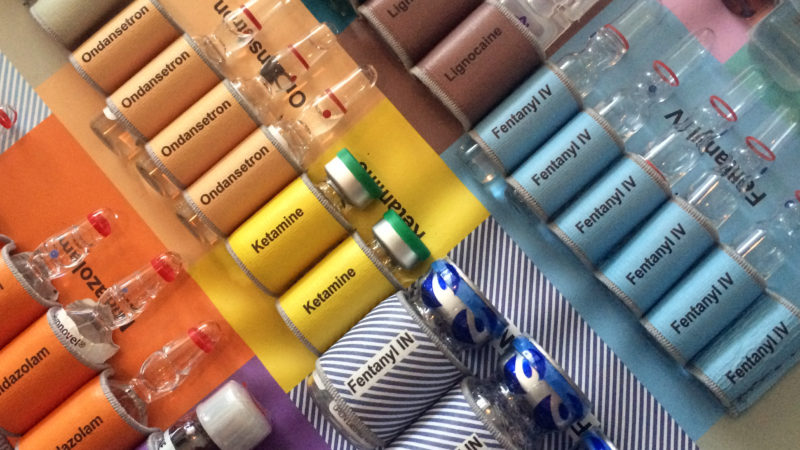Welcome to the April 2017 edition of PaReflectionEd Research Round-up, where we present recently published research from emergency medicine and critical care literature.
International research includes a study on consciousness during pulmonary resuscitation; paramedic competency; usefulness of 18-lead ECGs in STEMI, failure rate of pre-hospital chest decompression after severe thoracic trauma, ketamine as an adjunct to opioids for acute pain and paediatric pre-hospital medication dosing errors.
Enjoy.
If you come across any research reprints or articles that you think would be of interest to others, please email us for inclusion in the next edition.
Resuscitation
Consciousness induced during cardiopulmonary resuscitation: An observational study
Resuscitation: Volume 113, April 2017, Pages 44–50
In this retrospective study of registry-based data from Victoria, Australia, the authors aimed to describe cardiopulmonary resuscitation-induced consciousness (CPRIC) in out-of-hospital cardiac arrest (OHCA) patients and determine its association with survival outcomes. There were 112 (0.7%) cases of CPRIC among 16,558 EMS attempted resuscitations, increasing in frequency from 0.3% in 2008 to 0.9% in 2014.
CPR Induced Consciousness During Out-of-Hospital Cardiac Arrest: A Case Report on an Emerging Phenomenon
Prehospital Emergency Care: Volume 21, 2017 – Issue 2
High quality cardiopulmonary resuscitation (CPR) has produced a relatively new phenomenon of consciousness in patients with vital signs absent. This case report describes the manifestations of CPR induced consciousness as well as the resuscitative challenges which occur during resuscitation, including illustrating the need for sedation in a patient whose presentation was consistent with CPR induced consciousness.
Impact of cardiopulmonary resuscitation duration on neurologically favourable outcome after out-of-hospital cardiac arrest: A population-based study in Japan
Resuscitation: Volume 113, April 2017, Pages 1–7
This prospective, population-based observational study conducted in Osaka, Japan identified that the proportion of patients with neurologically favourable outcome declined with increasing CPR duration, but some out-of-hospital cardiac arrest patients could benefit from prolonged CPR duration >30 min. According to the study, the cumulative proportion for neurologically favourable outcome reached 99% after 44, 41, and 43 min of CPR in all patients, the shockable group, and the non-shockable group, respectively.
The association between diabetes status and survival following an out-of-hospital cardiac arrest: A retrospective cohort study
Resuscitation: Volume 113, April 2017, Pages 21–26
This is the first Canadian study to examine the association between diabetes status and out-of-hospital cardiac arrest outcomes. The results suggest that diabetes status prior to arrest is associated with decreased survival. A larger proportion of those with diabetes had a non-shockable initial rhythm and did not survive to hospital discharge.
Paramedic resuscitation competency: A survey of Australian and New Zealand emergency medical services
Prehospital and Retrieval Medicine: Volume 113, April 2017, Pages 21–26
The authors developed and conducted an online cross-sectional survey of Australian and New Zealand EMS aimed to identify the current practices within emergency medical services (EMS) for developing and maintaining paramedic resuscitation competency. All of the surveyed EMS provided initial resuscitation training to paramedics, but competency testing and refresher training practices varied between services. According to the results, resuscitation competency was tested by EMS: annually (3/9), biennially (4/9) or not at all (2/9). A lack of individual exposure to cardiac arrest and training time were identified as barriers to resuscitation competency.
Antiarrhythmic drugs for out-of-hospital cardiac arrest with refractory ventricular fibrillation
Critical Care (2017) 21:59
Recent guidelines on resuscitation recommend immediate defibrillation with CPR as the treatment of choice for out-of-hospital cardiac arrest (OHCA) patients with VF/pVT and that antiarrhythmic drugs (including amiodarone, lidocaine and nifekalant) can be used as advanced life support during cardiac arrest in patients with refractory ventricular dysrhythmias. This review suggests that amiodarone, lidocaine, and nifekalant therapies equally improve survival to hospital admission compared with placebo, however, none of these antiarrhythmic drugs improved long‐term outcomes. The authors also reported that among patients with bystander‐witnessed cardiac arrest, the survival rate was higher with amiodarone or lidocaine than with placebo. Although further studies are required to confirm this speculation, earlier administration of antiarrhythmic drugs may result in better outcomes.
Airway management
The Impact of a Soiled Airway on Intubation Success in the Emergency Department When Using the GlideScope or the Direct Laryngoscope
Academic Emergency Medicine: 16 January 2017
The objective of the study was to determine the impact of a soiled airway on first-pass success when using the GlideScope video laryngoscope or the direct laryngoscope for intubation in the emergency department (ED). Soiling of the airway was associated with a reduced first-pass success during emergency intubation, and this reduction occurred to a similar degree whether using either the GlideScope or the direct laryngoscope.
Cardiac
Usefulness of synthesized 18-lead electrocardiography in the diagnosis of ST-elevation myocardial infarction: A pilot study
American Journal of Emergency Medicine: March 2017, Volume 35, Issue 3, Pages 448–457
This pilot retrospective case-series study was performed to investigate whether synthesised 18-lead electrocardiogram (ECG) could improve the accuracy of infarction site diagnosis in patients presenting with ST-elevation myocardial infarction (STEMI). The diagnosis of STEMI by synthesised 18-lead ECG was found to be useful to identify the site of infarction in patients with infarction of the right ventricular wall (supplied by the RCA) or posterior wall of the left ventricle (supplied by the LCX). The authors showed that a synthesized 18-lead ECG, which compensates for the weaknesses of the standard 12-lead ECG, considered to be useful for the emergency diagnosis of STEMI, may be an excellent tool for early and accurate diagnosis of the site of STEMI. We think that dissemination of the easily usable synthesized 18-lead ECG is necessary to improve the quality of emergency cardiovascular care in the future.
Factors influencing choice of pre-hospital transportation of patients with potential acute coronary syndrome: An observational study
Prehospital and Retrieval Medicine: 25 January 2017
A study of patients presenting to ED with suspected acute coronary syndrome identified that patients with possible ischaemic symptoms who are at a high risk of cardiac disease do not utilise ambulance services more than low risk patients. According to the results, approximately half the patients (49.4%) assessed with symptoms of potential acute coronary syndrome used ambulance transport to the ED. The authors believe that transport to hospital using ambulance services by patients with symptoms of possible acute coronary syndrome is low despite community campaigns.
Trauma
Failure rate of prehospital chest decompression after severe thoracic trauma
American Journal of Emergency Medicine: March 2017, Volume 35, Issue 3, Pages 469–474
Pre-hospital needle thoracocentesis (NT) or tube thoracostomy (TT) is infrequently attempted in trauma patients. In this retrospective study, prehospital successful release of a tension pneumothorax was reported by the paramedics in 83% (5/6) with TT, whereas NT was effective in 18% only (3/17). Especially NT is associated with a high failure rate of more than 80%, potentially due to an inadequate ratio between chest wall thickness and catheter length as previously published as well as a possible different pathophysiological cause of respiratory distress. Therefore, TT may be considered already in the pre-hospital setting to retain sufficient pleural decompression upon admission.
Medical
Ketamine as an Adjunct to Opioids for Acute Pain in the Emergency Department: A Randomized Controlled Trial
Academic Emergency Medicine: 22 March 2017
The authors conducted a randomised, double-blinded, placebo-controlled trial evaluating the use of ketamine versus placebo in conjunction with opioids for moderate to severe pain. Ketamine, as an adjunct to opioid therapy, was identified to be more effective at reducing pain over 120 minutes and resulted in a lower total opioid dose as well as fewer repeat doses of analgesia. While more side effects were reported in the ketamine group (51% vs. 19%), the authors state the side effect profile appears tolerable.
Paediatrics
Pediatric Prehospital Medication Dosing Errors: A National Survey of Paramedics
Prehospital Emergency Care: Volume 21, 2017 – Issue 2
This survey of US paramedics demonstrated a significant number of paramedics are aware of paediatric dosing error, safety systems specific to paediatric patients are lacking, and that paramedics view specific safety measures such as paediatric drug cards, and eliminating drug calculations as helpful. The authors believe that significant progress needs to be made in improving paediatric patient drug-dosing safety in the pre-hospital environment.
Pediatric Disaster Triage: Multiple simulation curriculum improves prehospital care providers’ assessment skills
Prehospital Emergency Care: Volume 21, 2017 – Issue 2
This US study showed that a multiple-victim, multiple-simulation curriculum yields a durable 10% improvement in simulated triage accuracy. Triage accuracy of paramedics, paramedic students and EMTs were measured three times during a disaster simulation in which high and low fidelity manikins and actors portrayed 10 victims. After the first simulation participants conducted an online educational module and feedback was provided after each simulation. Accuracy was determined by participant triage decision concordance with predetermined expected triage level for each victim.
Psychiatric Emergencies
Ketamine reduces the need for intubation in patients with acute severe mental illness and agitation requiring transport to definitive care: An observational study
Emergency Medicine Australasia: 20 March 2017
This retrospective cohort study of mental health patients examined the effect of implementing a ketamine clinical practice guideline for agitated mental health patients. The authors identified the guideline was associated with an increase in the number of patients receiving ketamine as part of their sedation regime and a reduction in the number of patients requiring intubation for transport. The authors suggest that ketamine is considered as part of the sedation regime for agitated mental health patients.
Organisational
Evidence-Based Guidelines for Fatigue Risk Management in EMS: Formulating Research Questions and Selecting Outcomes
Prehospital Emergency Care: Volume 21, 2017 – Issue 2
The authors describe formulating and refining research questions, using the population, intervention, comparison, and outcome framework, and selection of outcomes to guide systematic reviews relevant to EMS fatigue risk management. There is also a protocol described for applying the Model Process and GRADE framework to create evidence-based guidelines.

